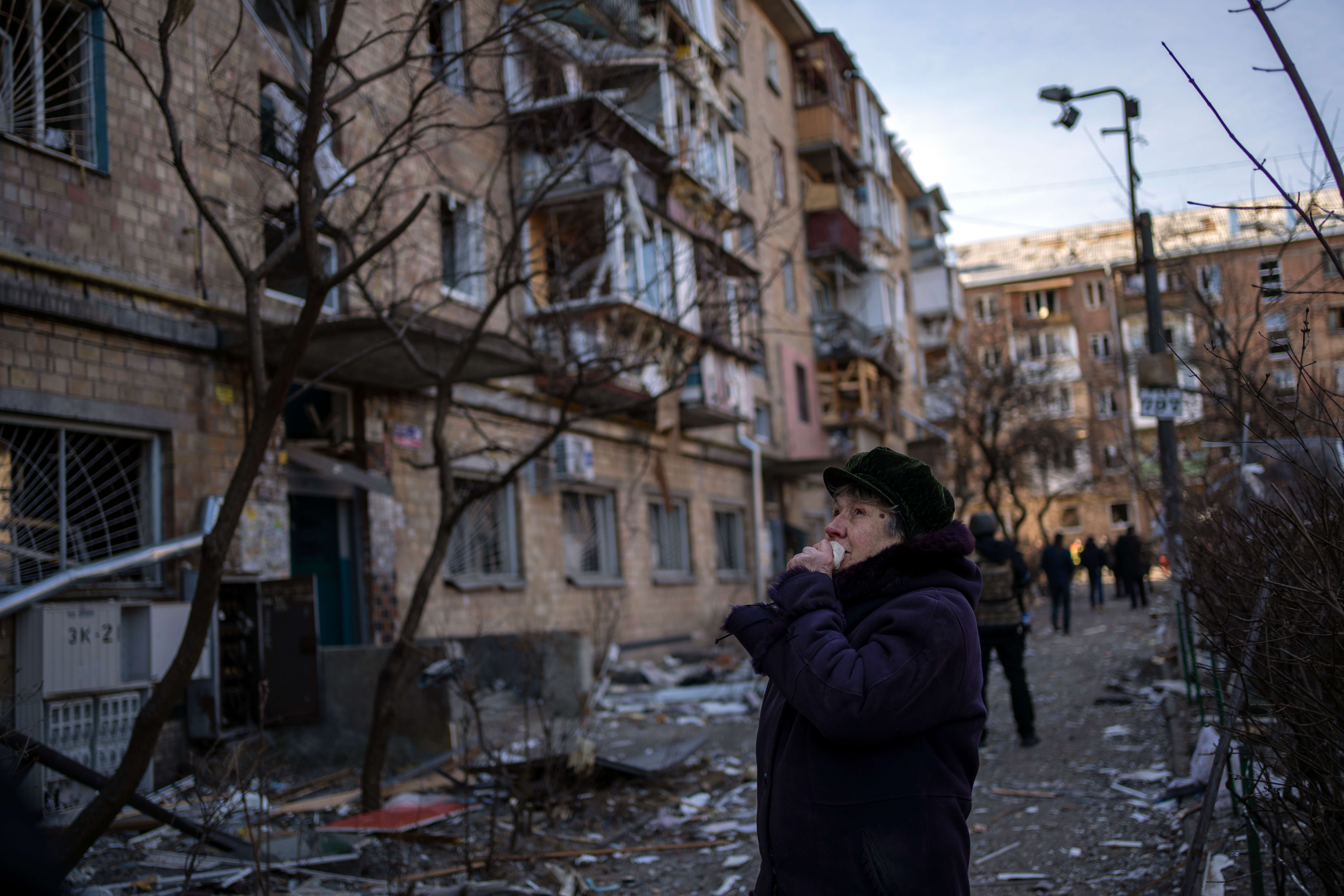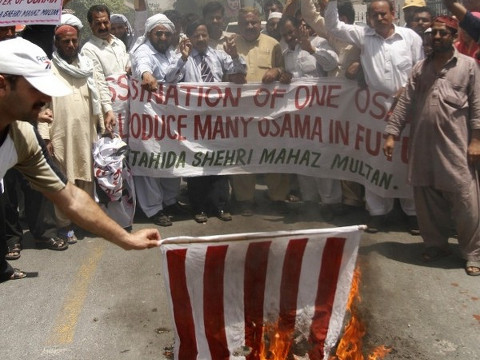
A woman looks at residential buildings damaged by a bomb in Kyiv, Ukraine, Friday, March 18, 2022. Russian forces pressed their assault on Ukrainian cities Friday, with new missile strikes and shelling on the edges of the capital Kyiv and the western city of Lviv, as world leaders pushed for an investigation of the Kremlin's repeated attacks on civilian targets, including schools, hospitals and residential areas. (AP Photo/Rodrigo Abd)
“Every minute you hear these explosions, these shots somewhere nearby, it’s hard to understand, are you a target? Even if it’s silent, the silence feels ominous. There is just this constant sense of danger.” That’s how Vika Kurilenko, mother of three, described living in a small town near Kyiv at the beginning of the war.
Their family escaped during active fighting. Her husband threw himself over their youngest daughter, trying to protect her from bullets and explosions. Her five-year-old thought it was a game.
“I write TV shows. But now I feel like I’m a character in one of them. I didn’t want to leave my homeland.”
Survivors of the Ukraine–Russia war continue to tell their horrific stories. But many thousands of soldiers and civilians have not survived.
So where does the war stand now? Is the end in sight?
President Biden’s stance
On May 31, President Biden wrote an op-ed in the New York Times titled “What America Will and Will Not Do in Ukraine.”
He begins, “The invasion Vladimir Putin thought would last days is now in its fourth month.” He’s right: Putin was overconfident in his initial push into Ukraine. President Biden goes on in the article to pledge another $700 million in military aid. Most importantly, the US is including advanced, long-range weaponry in this package. Biden has pledged to stick with Ukraine, but will not send troops to fight on the ground.
Where are the front lines of the Ukraine war?
In late April, Russia began focusing on the eastern region of Ukraine known as Donbas while abandoning the northern front and Kyiv. They also became more cautious after Ukraine’s surprisingly strong resistance. Russian troops are emphasizing artillery attacks and air superiority after their shoddy and beaten-back first wave.
For weeks, a small Ukrainian force has defended the southern city of Mariupol. A relentless barrage of fifty to one hundred bombs struck Mariupol every day in the siege. Eventually, the bulk of the two thousand or so remaining men holed up in a steel plant. In mid-May, Russia announced it had seized Mariupol and evacuated surrendered Ukrainian forces.
This victory was an important strategic win for Russia but much more costly than expected. People have called this courageous holdout by Ukrainians a “David and Goliath” story, and Russian casualties were high.
According to Ukraine, they are holding out in Severodonetsk, an eastern city on the frontlines (although Russia now controls most of the city as of this writing). Meanwhile, Russia is making advances in the south and has connected the eastern and southern fronts by capturing Mariupol.
But, if that paints a picture of an inevitable Russian victory, think again.
Russia’s embarrassing setbacks
Russia’s initial push was expected to take all of Ukraine easily, even within days by some Russian estimates. Poor logistics and a ferocious Ukrainian resistance pushed back Russian forces in the north. Russia scaled back its objectives to capture the eastern region, Donbas. Now it’s having to narrow these goals even further because of the resistance.
Russian forces continue to suffer lower and lower morale. They are looting grocery stores because supply lines aren’t getting them enough food. Their style of warfare is outdated. Their military command is dysfunctional, relying on generals to make tactical decisions. So, the generals went to the front lines for quicker communication, but, as result, a shocking twelve Russian generals have died so far in the war.
These factors have severely handicapped Russia’s army.
And, the world continues to rally behind Ukraine. In a stunning move, both Finland and Sweden announced they would apply to join NATO in mid-May, a historic turn for both countries.
While Putin claims NATO was encroaching against Russia, it was Russia’s invasion of Ukraine that, ironically, caused those nations to apply for NATO membership.
Civilians casualties and Russian war crimes
At certain points, Russia and Ukraine established temporary peaceful lanes of passage called humanitarian corridors. These corridors allow civilians to safely leave a besieged city. However, Russia was accused of shelling the corridors anyway, killing civilians and drawing even louder international condemnation.
Civilian deaths have continued to climb. Russian troops continue to target areas it knows citizens are taking shelter in. Additionally, Russians had cut the water and electricity into Mariupol as part of their siege, a devastating blow to civilians left inside.
The UN reports conservative and confirmed numbers of over four thousand civilians killed. Ukraine reports 243 children are confirmed dead from the war. They also speculate that thousands of civilians have died in Mariupol alone due to the constant shelling. Mariupol’s mayor estimates the civilian death toll is twenty-one thousand. Around 6.8 million refugees have fled from Ukraine. And 14 million have been forced to leave their homes, which is about 30 percent of their total population.
The first Russian war criminal was sentenced to a lifetime in prison on May 23. The twenty-one-year-old soldier said he acted on orders to execute an elderly civilian.
Whether the Kremlin wins or loses, Russia and Putin will remain pariahs in the eyes of the world for a long time.
The uncertain future
Both Zelensky and Putin haven’t backed down an inch from fighting for Donbas.
If you are wondering why Putin decided on this invasion, Dr. Ryan Denison wrote about Putin’s idea of destiny and I’ve written about the history of Ukraine and Russia. Dr. Jim Denison wrote an illuminating article on Volodymyr Zelensky and how we can pray for him.
While Russia uses “saber-rattling” rhetoric with nuclear bombs, most believe Putin won’t resort to nukes in this war. The West continues to send billions of dollars of aid, both militarily and humanitarian, to Ukraine. Sanctions tighten around Russia. President Biden has been adamant that he will not back down from helping Ukraine.
With this in mind, experts can only speculate as to the future.
In one scenario, Russia takes and holds the Donbas region and Putin spins this as a “win” for Russia. A stalemate seems likelier. Then, they would eventually negotiate, and Ukraine might lose the states of Luhansk and Donetsk. Ukraine might then become a neutral “buffer zone” and would have to take years to build back.
But that future is still entirely uncertain.
How can you help?
Churches in Ukraine and other countries around Ukraine continue to show brave and overwhelming support for Ukrainian refugees.
Pray for Ukraine.
You’ve probably seen plenty of social media posts urging people to pray for Ukraine. But, it’s true that prayer is powerful and effective. Ask the Lord to end the war quickly and that he would show you how he’s leading you to help.
With more and more aid being sent, it is still important to give financial support. Ukrainians need basic supplies like food and water and have to make a temporary life away from their homes.
I know the Lord is calling believers to adopt children displaced, orphaned, and hurting from Ukraine. The government recently made it easier to adopt. It’s a long, arduous process and a lifelong commitment. But act on the prompting of the Spirit with consideration and faith if that’s an option for your family.
Go yourself.
If you have the ability and special skills (like medical training), consider going to surrounding countries to help. World Medical Mission from Samaritan’s Purse is one way. The greatest need believers can meet is by helping lost and hurting refugees.
Help incoming Ukrainian refugees.
Your church can help sponsor Ukrainians who are being resettled in the US. As many as one hundred thousand will eventually move to the US.
The war in Ukraine rages on, and the conflict will likely continue for many months. As it always has, the church must step up to bring relief and the gospel as it goes into dark places.













